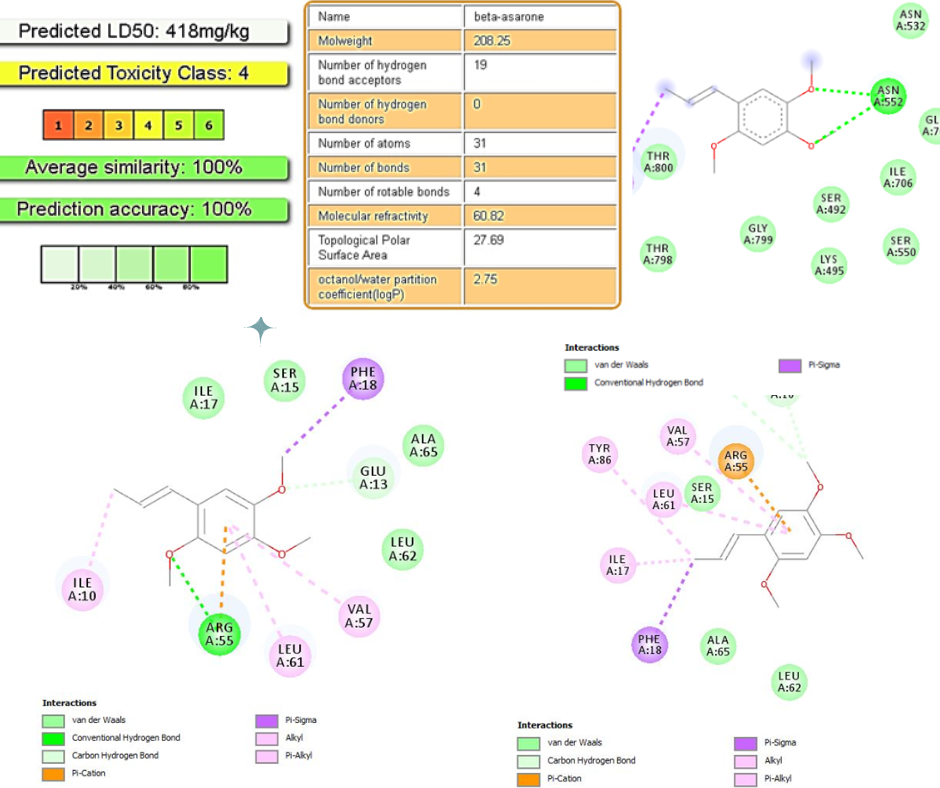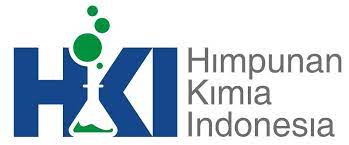
Studi docking untuk skrining senyawa antibakteri dari Jeringau Merah (Acorus calamus L.) menggunakan protein Shigella flexneri sebagai model sistem
Penulis
Riyadh Aqilsya Amaryl Dyas , Bambang Wijianto , Hariyanto IHDOI:
10.29303/aca.v6i2.161Diterbitkan:
2023-06-24Terbitan:
Vol 6 No 2 (2023)Kata Kunci:
Red Jeringau (Acorus calamus L.), α and β-Asarone, Antibacterial, Autodock VINA, ProTox-II5Articles
Unduhan
Cara Mengutip
Unduhan
Metrik
Abstrak
Alfa dan Beta asarone diidentifikasi sebagai senyawa utama dari Jeringau merah (Acorus calamus L.) yang terkandung pada seluruh bagian tanaman dan diduga memiliki sifat antimikroba. Tujuan dari penelitian ini adalah untuk mengkaji mekanisme antibakteri kedua senyawa tersebut terhadap Shigella flexneri melalui studi penambatan molekul senyawa ligan alfa dan beta asarone terhadap protein PBP2 dan 50S Ribosomal Protein dengan AutoDock Vina. Protokol penambatan molekul menggunakan perangkat PyRx dilakukan dengan nilai Exhaustiveness = 106, grid x = 38.738375, y = 112.645792, z = 46.926417 untuk PBP2, dan grid x = 71.721251, y = 47.551601, z = 9.663173 terhadap 50S Ribosomal Protein. Hasil penambatan molekul pada senyawa alfa asarone diperoleh nilai afinitas sebesar -5,7 kcal/mol terhadap PBP2 dan nilai afinitas sebesar -5,6 kcal/mol terhadap 50S Ribosomal Protein, sedangkan beta asarone memiliki nilai afinitas sebesar -5,6 kcal/mol terhadap PBP2 dan nilai afinitas sebesar -5,7 kcal/mol pada 50S Ribosomal Protein. Dibandingkan dengan kontrol, afinitas alfa dan beta asarone bernilai lebih besar. Penambatan molekul senyawa alfa dan beta asarone menghasilkan ikatan ionik pada asam amino TYR529 dan ikatan polar pada asam amino ASN552 dari PBP2. Namun hanya beta asarone yang menghasilkan ikatan ionik pada asam amino ILE17 dan ikatan polar pada asam amino GLU13 dari 50S Ribosomal Protein. Berdasarkan penelitian ini, senyawa alfa dan beta asarone terbukti memiliki aktivitas antibakteri terhadap bakteri Shigella flexneri melalui gangguan permeabilitas dinding sel bakteri. Kedua senyawa juga diprediksi memiliki efek karsinogenik dan mutagenik.
Referensi
Schnupf Pamela, Sansonetti Philippe J. (2019). Shigella Pathogenesis: New Insights through Advanced Methodologies. Microbiol. Spectr. 7, 7.2.28. doi:10.1128/microbiolspec.BAI-0023-2019.
Baker, S., The, H.C. (2018). Recent insights into Shigella. Curr Opin Infect Dis. 31, 449–454. doi:10.1097/QCO.0000000000000475.
Williams, P.C.M., Berkley, J.A. (2018). Guidelines for the treatment of dysentery (shigellosis): a systematic review of the evidence. Paediatr Int Child Health. 38, S50–S65. doi:10.1080/20469047.2017.1409454.
Pakbin, B., Brück, W.M., Brück, T.B. (2023). Molecular Mechanisms of Shigella Pathogenesis; Recent Advances. Int. J. Mol. Sci. 24. doi: 10.3390/ijms24032448.
Miti, S., Chilyabanyama, O.N., Chisenga, C.C., Chibuye, M., Bosomprah, S., Mumba, C., Chitondo, S., Siziya, S., Cohen, D., Chilengi, R., Simuyandi, M. (2023). Sensitivity and predictive value of dysentery in diagnosing shigellosis among under five children in Zambia. PLoS One. 18, e0279012–e0279012. doi:10.1371/journal.pone.0279012.
Nasser, A., Mosadegh, M., Azimi, T., Shariati, A. (2022). Molecular mechanisms of Shigella effector proteins: a common pathogen among diarrheic pediatric population. Mol Cell Pediatr. 9, 12–12. doi:10.1186/s40348-022-00145-z.
Gharpure, R., Marsh, Z.A., Tack, D.M., Collier, S.A., Strysko, J., Ray, L., Payne, D.C., Garcia-Williams, A.G. (2021). Disparities in Incidence and Severity of Shigella Infections Among Children-Foodborne Diseases Active Surveillance Network (FoodNet), 2009-2018. J Pediatric Infect Dis Soc. 10, 782–788. doi:10.1093/jpids/piab045.
Bowen, A., Eikmeier, D., Talley, P., Siston, A., Smith, S., Hurd, J., Smith, K., Leano, F., Bicknese, A., Norton, J.C., Campbell, D., Centers for Disease Control and Prevention (CDC). (2015). Notes from the Field: Outbreaks of Shigella sonnei Infection with Decreased Susceptibility to Azithromycin Among Men Who Have Sex with Men - Chicago and Metropolitan Minneapolis-St. Paul, 2014. MMWR Morb Mortal Wkly Rep. 64, 597–598.
Ranganathan, S., Doucet, M., Grassel, C.L., Delaine-Elias, B., Zachos, N.C., Barry, E.M. (2019). Evaluating Shigella flexneri Pathogenesis in the Human Enteroid Model. Infect Immun. 87, e00740-18. doi:10.1128/IAI.00740-18.
Kelmani R, C. (2018). Shigellosis: Its Prevention and Management Issues. CDVS. 1. doi:10.32474/CDVS.2018.01.000121.
Ranjbar, R., Farahani, A. (2019). Shigella: Antibiotic-Resistance Mechanisms and New Horizons for Treatment. Infect Drug Resist. 12, 3137–3167. doi:10.2147/IDR.S219755
Muchtaromah, B., Hayati, A., Agustina, E. (2019). Phytochemical Screening and Antibacterial Activity of Acorus calamus L. Extracts. Jurnal Biodjati. 4, 68–78. doi:10.15575/biodjati.v4i1.4235.
Rita, W.S., Swantara, I.M.D., Utami, G.A.P. (2019). Antimicrobial activity of Acorus calamus L. rhizome extract and its total flavonoid and phenolic contents. AIP Conference Proceedings. 2155, 020054. doi:10.1063/1.5125558.
Wijianto, B., Ritmaleni, R., Purnomo, H., Nurrochmad, A. (2019). In silico and in vitro assay of HGV analogue as antibacterial. Int J Pharm Pharm Sci. 11, 78–85. doi:10.22159/ijpps.2019v11i3.30581.
Wijianto, B., Ritmaleni, R., Purnomo, H., Nurrochmad, A. (2020). In silico and in vitro anti-inflammatory evaluation of 2,6-bis-(3’-ethoxy, 4’-hydroxybenzylidene)-cyclohexanone, 2,6-bis-(3’-Bromo,4’-methoxybenzylidene)-cyclohexanone, and 2,6-bis- (3’,4’-dimethoxybenzylidene)-cyclohexanone. J app pharm sci. 10, 99–106. doi:10.7324/JAPS.2020.10613.
Wijianto, B., Ritmaleni, Purnomo, H., Nurrochmad, A. (2020). Curcumin mono-carbonyl analogs as potent antibacterial compounds: synthesis, biological evaluation and docking simulation study. RJC. 13, 1153–1165. doi:10.31788/RJC.2020.1325554.
Eberhardt, J., Santos-Martins, D., Tillack, A.F., Forli, S. (2021). AutoDock Vina 1.2.0: New Docking Methods, Expanded Force Field, and Python Bindings. J. Chem. Inf. Model. 61, 3891–3898. doi: 10.1021/acs.jcim.1c00203.
Zapun, A., Contreras-Martel, C., Vernet, T. (2008). Penicillin-binding proteins and β-lactam resistance. FEMS Microbiology Reviews. 32, 361–385. doi: 10.1111/j.1574-6976.2007.00095.x.
Watkins, R.R., Bonomo, R.A. (2017). 140 - β-Lactam Antibiotics. In: Cohen, J., Powderly, W.G., and Opal, S.M. (eds.) Infectious Diseases (Fourth Edition). pp. 1203-1216.e2. Elsevier.
López-Jacome, L.E., Mercado-Casillas, Y.M., Méndez-Sotelo, B.J., Jiménez-Cortes, J.G., Tovar-García, A., Estrada-Velasco, A.Y., Almeida-Villegas, J.A., Martínez, J.D.P., García-Contreras, R. (2022). Anti-Bacterial Agents. In: Rezaei, N. (ed.) Encyclopedia of Infection and Immunity. pp. 494–509. Elsevier, Oxford.
Trott, O., Olson, A.J. (2010). AutoDock Vina: improving the speed and accuracy of docking with a new scoring function, efficient optimization, and multithreading. J Comput Chem. 31, 455–461. doi:10.1002/jcc.21334.
Wang, R., Lai, L., Wang, S. (2002). Further development and validation of empirical scoring functions for structure-based binding affinity prediction. J. Comput. Aided Mol. 16, 11–26. doi:10.1023/A:1016357811882.
Hassan, N.M., Alhossary, A.A., Mu, Y., Kwoh, C.-K.: Protein-Ligand Blind Docking Using QuickVina-W With Inter-Process Spatio-Temporal Integration. Scientific Reports. 7, 15451 (2017). doi:10.1038/s41598-017-15571-7.
Quiroga, R., Villarreal, M.A. (2016). Vinardo: A Scoring Function Based on Autodock Vina Improves Scoring, Docking, and Virtual Screening. PLOS ONE. 11, e0155183. doi:10.1371/journal.pone.0155183.
Tang, S., Chen, R., Lin, M., Lin, Q., Zhu, Y., Ding, J., Hu, H., Ling, M., Wu, J. (2022). Accelerating AutoDock Vina with GPUs. Molecules. 27. doi:10.3390/molecules27093041.
Wijianto, B., Hamzah, H., Nurhidayah A. L., Kemuning G. I., Dyas, R. A. A,. (2022). Characterization of Onchidiid Slug (Onchidium typhae) West Kalimantan Waters as Antibacterials and Antifungal. Borneo Journal of Pharmacy. 5, 35–41. doi:10.33084/bjop.v5i1.2936.
Zoete, V., Grosdidier, A., Michielin, O. (2009). Docking, virtual high throughput screening and in silico fragment-based drug design. J Cell Mol Med. 13, 238–248. doi:10.1111/j.1582-4934.2008.00665.x.
Morris, G.M., Huey, R., Lindstrom, W., Sanner, M.F., Belew, R.K., Goodsell, D.S., Olson, A.J. (2009). AutoDock4 and AutoDockTools4: Automated docking with selective receptor flexibility. J. Comput. Chem. 30, 2785–2791. doi:10.1002/jcc.21256.
Hill, A.D., Reilly, P.J. (2015). Scoring Functions for AutoDock. In: Lütteke, T. and Frank, M. (eds.) Glycoinformatics. pp. 467–474. Springer New York, New York, NY
Wu, D., Karimi-Maleh, H., Liu, X., Fu, L.: Bibliometrics Analysis of Research Progress of Electrochemical Detection of Tetracycline Antibiotics. J. Anal. Chem. 2023, 6443610 (2023). https://doi.org/10.1155/2023/6443610
Banerjee, P., Eckert, A.O., Schrey, A.K., Preissner, R. (2018). ProTox-II: a webserver for the prediction of toxicity of chemicals. Nucleic Acids Res. 46, W257–W263. doi:10.1093/nar/gky318.
Cartus, A.T., Schrenk, D. (2016). Metabolism of the carcinogen alpha-asarone in liver microsomes. FCT. 87, 103–112. doi:10.1016/j.fct.2015.11.021.
Cartus, A.T., Stegmüller, S., Simson, N., Wahl, A., Neef, S., Kelm, H., Schrenk, D. (2015). Hepatic Metabolism of Carcinogenic β-Asarone. Chem. Res. Toxicol. 28, 1760–1773. doi:10.1021/acs.chemrestox.5b00223.
Lisensi
Hak Cipta (c) 2023 Riyadh Aqilsya Amaryl Dyas, Bambang Wijianto, Hariyanto IH

Artikel ini berlisensiCreative Commons Attribution-NonCommercial-ShareAlike 4.0 International License.
Authors who publish with ACA: Acta Chimica Asiana agree to the following terms:
- Authors retain copyright and grant the journal right of first publication with the work simultaneously licensed under a Creative Commons Attribution-NonCommercial-ShareAlike 4.0 International License. This license allows authors to use all articles, data sets, graphics, and appendices in data mining applications, search engines, web sites, blogs, and other platforms by providing an appropriate reference. The journal allows the author(s) to hold the copyright without restrictions and will retain publishing rights without restrictions.
- Authors are able to enter into separate, additional contractual arrangements for the non-exclusive distribution of the journal's published version of the work (e.g., post it to an institutional repository or publish it in a book), with an acknowledgement of its initial publication in ACA: Acta Chimica Asiana.
- Authors are permitted and encouraged to post their work online (e.g., in institutional repositories or on their website) prior to and during the submission process, as it can lead to productive exchanges, as well as earlier and greater citation of published work (See The Effect of Open Access).





 Indonesian Chemical Society, Chapter Nusa Tenggara. Jalan Majapahit 62 Mataram, University of Mataram, 83125, Indonesia
Indonesian Chemical Society, Chapter Nusa Tenggara. Jalan Majapahit 62 Mataram, University of Mataram, 83125, Indonesia





